Publication
auri Research Brief
The Preservation and Management Status of State-registered Cultural Heritage and Measures for Enhancing the System
- No.86
- 2023.11.28
- Hit 2742
- Son, Eunshin Associate Research Fellow
- Lee, Geauchul Research Fellow
Following the registration standards for state-registered cultural heritage, buildings constructed after the 1960s are now subject to registration. Given that buildings constructed after the 1960s exhibit greater diversity in terms of scale, materials, and construction methods and have been mass-produced compared to their predecessors, it is essential to review the preservation, management and support system for state-registered cultural heritage while considering the changing characteristics of eligible properties. By examining the current state-registered cultural heritage management system and the newly enacted “Act on the Preservation and Utilization of Modern and Contemporary Cultural Heritage,” this paper presented the principles of preserving and managing state-registered cultural heritage and proposed measures to enhance the system, including the management of registered values, modifications of support standards, and the creation of a technical support system.
Changes in Conditions for State-registered Cultural Heritage
State-registered cultural heritage refer to properties constructed, produced, or formed more than 50 years ago among the cultural properties that have not been designated as cultural heritage but have been registered through deliberation by the Cultural Heritage Committee due to the special need for their preservation and utilization.1) Starting in 2024, the law applicable to state-registered cultural heritage will change from the current “Cultural Heritage Protection Act” to the newly enacted “Act on the Preservation and Utilization of Modern and Contemporary Cultural Heritage(hereinafter referred to as the “Modern and Contemporary Cultural Heritage Act”). However, the registration criteria, which require properties to be “constructed, produced, or formed at least 50 years ago,” will remain the same in the new act.2)
This is changing as the scope of eligible state-registered cultural heritage has been expanded to include properties from the 1960s and 1970s under the criterion of properties being “50 years or older” as stipulated in the law. Most state-registered cultural properties today consist of buildings and facilities from the 1910s to the 1950s, most of which are wood or masonry buildings that are relatively small. However, as buildings and facilities from the 1960s and 1970s, which are now 50 years or older, have newly become eligible for registration, it is impossible to overlook the various building types, including the reinforced concrete buildings that were constructed en masse after National liberation of Korea and the steel frames and curtain walls built since the 1960s.
In response to these changes in conditions, the UNESCO Hall in Myeong-dong, with one basement, thirteen floors, and a floor area of 13,367.1㎡, was registered as a state-registered cultural heritage site in July 2022. The UNESCO hall was recognized for its technical and historical significance, as it was built using the curtain wall construction method, a rarity in Korea when the building was established in 1967. As demonstrated by this example, buildings constructed since the 1960s in Korea that can be considered modern architectural cultural heritage differ from earlier buildings in terms of their large scale, variety, and size (Suzuki, 2001, p.18) by being high-rise structures with more than ten floors, large-scale buildings with a floor area of 10,000㎡ or more, and incorporating various modern techniques. Given the significant increase in the number and size of buildings constructed during this period, it is essential to review the existing system for preserving, managing, and supporting state-registered cultural heritage in consideration of the characteristics of the newly eligible properties.
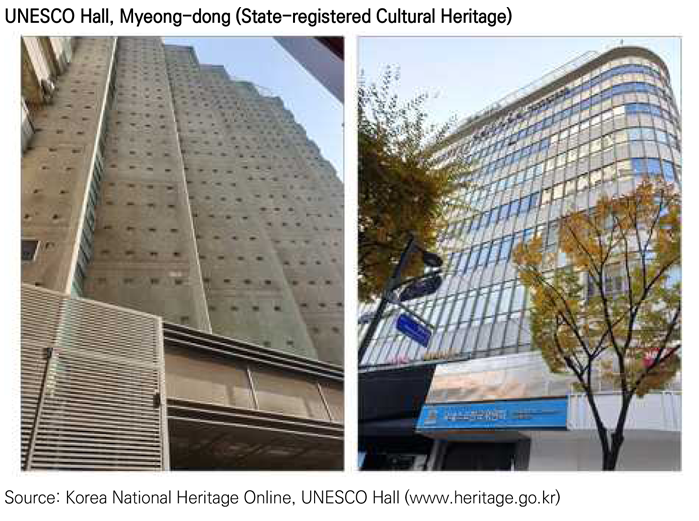
- The Current Management System of State-Registered Cultural Heritage
The current management system for state-registered cultural heritage can be organized into three components under the current Cultural Heritage Protection Act: regular investigations, repairs and maintenance (lump-sum budget), and technical guidance and reviews.
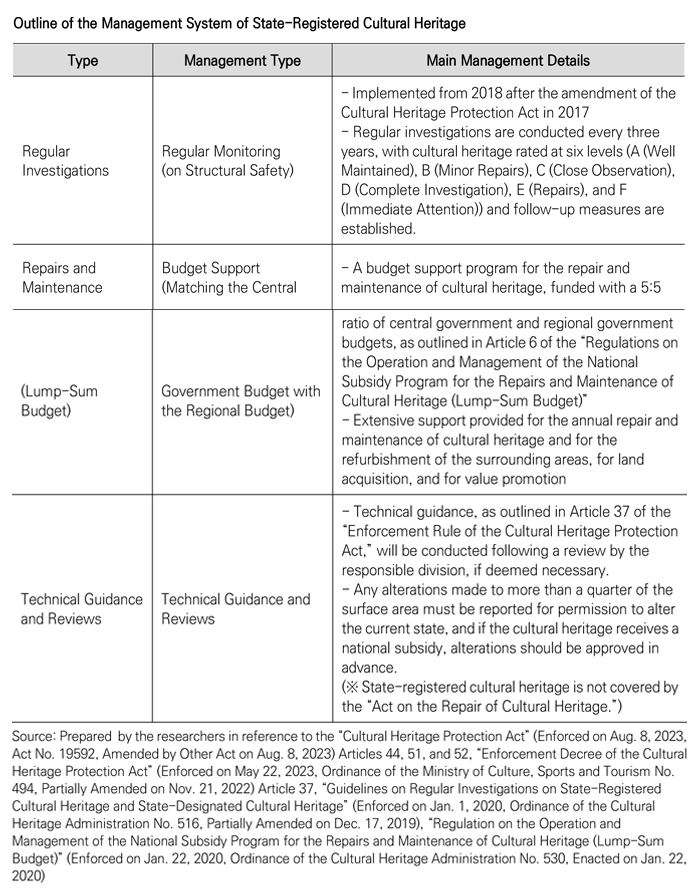
- Regular Investigations
Regular investigations of state-registered cultural heritage involve monitoring the preservation and management status of buildings and facilities. The amendment of the “Cultural Heritage Protection Act” in 2017 laid the foundation for regular investigations of state-registered cultural heritage, and regular investigations have been conducted every three years since 2018. After the change, 157 investigations were held in 2018, 187 in 2019, 211 in 2020, and 183 in 2021 (Cultural Heritage Administration, 2022b).3)
The regular investigations categorize the preservation status of cultural heritage into six levels: A (Well Maintained), B (Minor Repairs), C (Close Observation), D (Complete Investigation), E (Repair), and F (Immediate Attention). Level C is further divided into C1 and C2, with cultural properties classified as C2 or below requiring measures more extensive than partial repairs. Four years of regular investigations conducted until 2021, finding that 127 out of 738 cultural properties (17.2%), approximately one-sixth of the total, were rated C2 or below, indicating the need for more than partial repairs. Cultural properties that were in the process of being repaired, on the other hand, were labeled as “Ungraded,” with 121 cultural properties (16.4%) falling under the “Ungraded (Under Repair)" category, confirming that one-third of the state-registered cultural heritage properties were either under repair or in need of further repair.
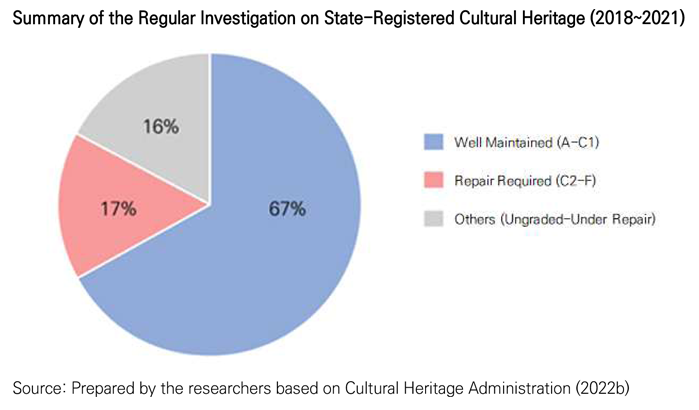
This raises the question of how efficiently has state-registered cultural heritage been preserved and managed through regular investigations. An assessment of changes among the 157 cultural properties inspected in 2018 and fully re-inspected in 2021 revealed that out of the 14 cultural properties initially rated C2 or below, eleven saw improvements in their ratings, while two remained at the same level, and one was downgraded due to damage caused by strong wind during that year. According to the regular investigation report on the eleven improved cases in 2021, these cultural properties underwent repairs and reinforcements between 2019 and 2021 following the initial regular investigation in 2018.
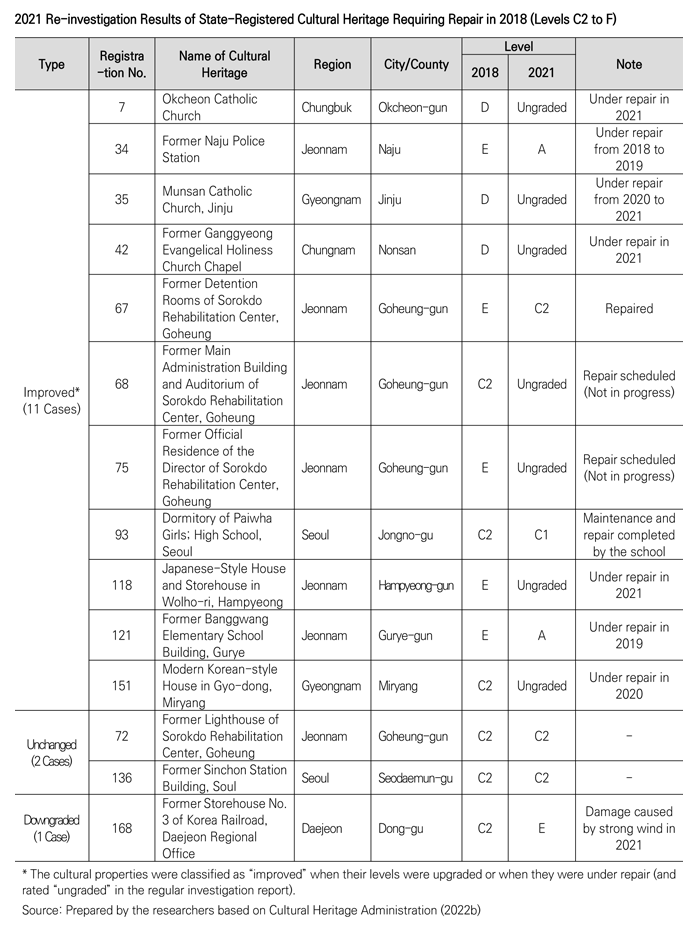
Given that the purpose of the state-registered cultural heritage is to preserve values for sustainable use flexibly, instead of adhering to the frozen preservation principle, repairing it to address possible damage is recommended but not mandatory. In other words, while repairs for low-rated cultural properties (ranging from D to F) through regular investigations are prioritized in the application for the Cultural Heritage Administration's budget support program, such repairs are not compulsory. Considering that state-registered cultural heritage rated C2 or below as a result of regular investigations has been appropriately addressed under specific conditions, the preservation status of state-registered cultural heritage appears to be monitored effectively at an appropriate level.
- Repairs and Maintenance (Lump-Sum Budget)
The current budget support for state-registered cultural heritage operates under Article 6 of the “Regulation on the Operation and Management of the National Subsidy Program for the Repairs and Maintenance of Cultural Heritage (Lump-Sum Budget),” with a 5:5 funding ratio between the central government and regional government. The scope of support is identical to that for state-designated cultural heritage. The budget basically covers everything necessary for cultural heritage management, including repairs such as general fixes, restoration, deconstruction, and renovation, as well as land and building acquisition, the installation of protective facilities, archiving and research projects, the installation and maintenance of facilities for the management and visitors, expenditures on exhibition halls built to enhance the value of cultural heritage, and landscape maintenance.
The process begins with an application submitted by the basic local government where the cultural heritage is situated, which is approved by the metropolitan local government and reviewed by the relevant division at the Cultural Heritage Administration (Modern Cultural Heritage Division) that disburses the subsidy. The metropolitan government is eligible to apply for the subsidy in cases where the cultural heritage in need of repair is state-owned or does not have a registered owner. Cultural properties rated from levels C to F in the regular investigation, in particular, are strongly encouraged to apply for subsidies and are prioritized in the application process. After the subsidies are allocated, the repair work is executed, and the budget is managed by the respective basic local government.
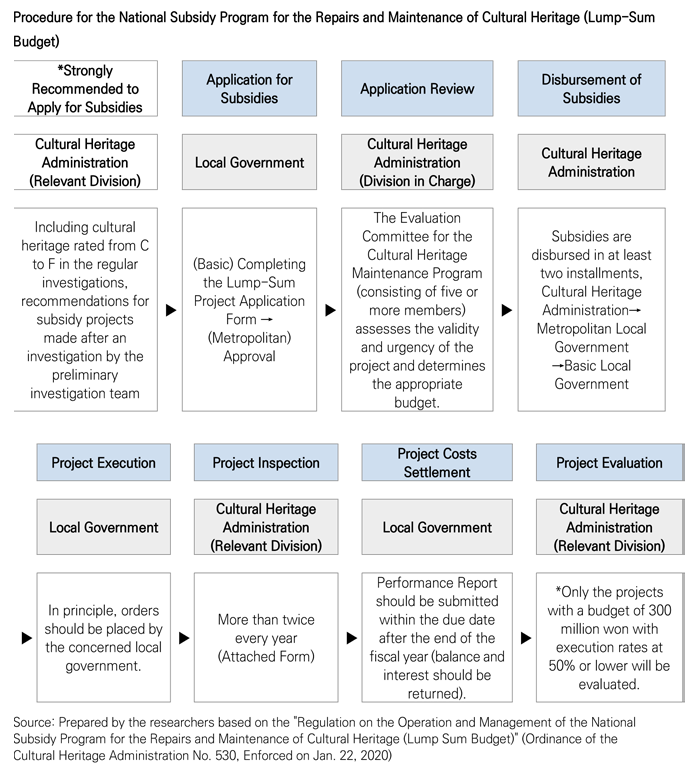
The budget allocated for the repairs and maintenance of state-registered cultural heritage has seen a continuous increase. The budget, which was approximately 11 billion won in 2013 (including funds from the central government and local governmental budgets) tripled in 2022 to approximately 33.3 billion won, and the number of repairs and maintenance projects also increased by about 1.8 times, from 80 in 2013 to 147 in 2022.4) As of 2022, 87% of these cases, or 128 out of the 147 cases of state-registered cultural heritage requiring repairs and maintenance, were buildings, excluding movable assets. Moreover, the majority of the budget for the repairs and maintenance of state-registered cultural heritage (lump-sum budget) was allocated to buildings and facilities, as the budget for the repairs and maintenance of buildings was 31.5 billion won, making up 95% of the total budget.
This study reclassified and examined the ten supported items outlined in Appendix Table 1 of the “Regulation on the Operation and Management of the National Subsidy Program for the Repairs and Maintenance of Cultural Heritage (Lump-Sum Budget)” into five categories: repair, maintenance, acquisition, archiving and research, and other expenditures.
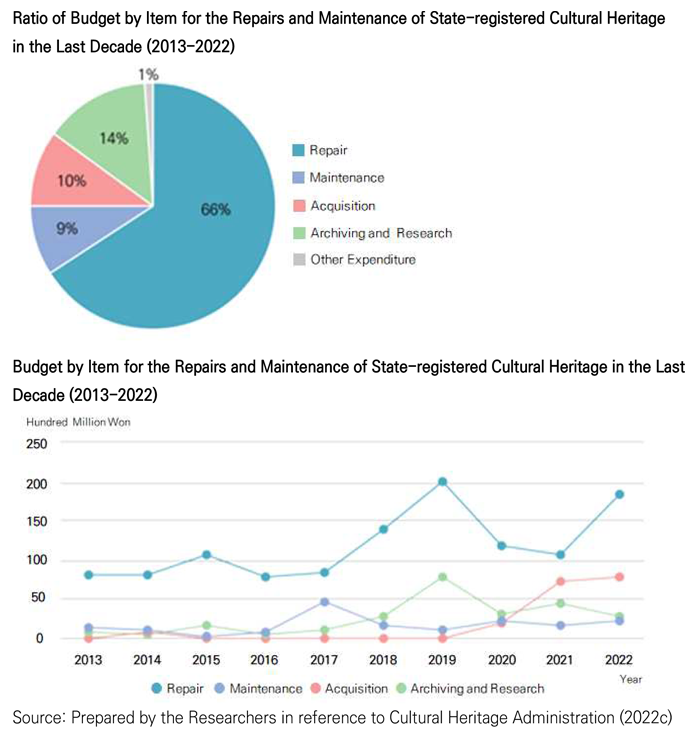
First, repairs have constituted 66% of the budget for the Repairs and Maintenance of State-registered Cultural Heritage over the past decade, as it increased by approximately 2.3 times from 8.1 billion won in 2013 to 18.6 billion won in 2022. In terms of maintenance costs, encompassing expenses for cultural protection facilities, management facilities, visitor facilities, additional facilities and the maintenance of surrounding areas, these costs accounted for 9% of the total budget in the last decade. In addition, 2.3 billion won was used in 2022, increasing by 1.7 times over the last decade. While repairs and maintenance are vital components of the repairs and maintenance program, with repairs being the budget’s largest item, the increase in the overall budget for repairs and maintenance has been relatively small compared to the threefold increase in the overall budget.
On the other hand, acquisition costs have increased significantly in recent years. Budget support for acquisition expenses accounted for only 10% of the total support budget, but the total acquisition costs from 2013 to 2019, which stood at 970 million won, increased dramatically in the ensuing three years from 2020 to 2022 to 16.9 billion won. This substantial increase in acquisition costs during these three years is largely attributed to the acquisition of modern and contemporary historical spaces, which are cultural heritage registered at the myeon level. The budget for archiving and research has also increased over the past decade. The budget for archiving and research in the last decade amounted to about 24.9 billion won, which accounts for 14% of the entire budget and is the second largest budget item after repairs. In 2022, 2.8 billion won was allocated for this item, indicating a 4.2-fold increase over the previous ten years.
- Technical Guidance and Reviews
At present, there are no existing guidelines or policies for technical guidance and design reviews regarding the repair and maintenance of state-registered cultural heritage.
First, regarding technical guidance, Article 37 of the “Enforcement Rule of the Cultural Heritage Protection Act” states that technical guidance related to the management and repair of state-registered cultural heritage can be requested, but only when it is deemed necessary through professional consultations in accordance with the case-specific guidelines set by the Cultural Heritage Administration. The Cultural Heritage Repair Handbook limits the eligibility for the technical guidance program to state-designated cultural heritage, whereas state-registered cultural heritage is not included in the Act on Repair of Cultural Heritage, the representative act pertaining to the repair of cultural heritage. Consequently, repair, measurement, design, and construction supervision of state-registered cultural heritage are not addressed by current law.
Relevant guidelines do include the “Standard Specifications for the Repair of Modern Cultural Heritage Buildings.” The standard specifications were developed to repair modern buildings in the aforementioned repairs and maintenance program (lump-sum budget). However, compared to state-designated cultural heritage, the guidelines on the repairs and maintenance program (lump-sum budget) for state-registered cultural heritage are brief. Furthermore, the standard specifications mainly focus on low-rise wooden or masonry buildings from the modern period. The characteristics of large-scale buildings, such as the UNESCO Hall built in the 1960s, that use new technology, materials, and methods of construction that cannot be disassembled and repaired, call for different repair guidelines and technical guidance methods.
Moreover, any alterations affecting more than one-fourth of the exterior of state-registered cultural heritage buildings or any movement or demolition of such buildings must be reported to obtain permission to alter the current state. For cases in which the cultural heritage building received national subsidies through the repair and maintenance (lump-sum budget) program or has been granted a permit by applying exceptions to the building-to-land ratio and floor space ratio, permissions for the altering of the current state can only be granted when the cultural heritage is state-owned or owned by the local government.5) Due to such regulations, it becomes difficult for the local governments or the Cultural Heritage Administration to be immediately aware of alterations to cultural properties that have not received any state subsidies and have not changed more than one-fourth of their exterior designs.
Management Principles for State-registered Cultural Heritage
How should state-registered cultural heritage be preserved and managed? Designated cultural heritage, such as national treasures, treasures, and historic sites, does not require the owner’s consent for designation as a cultural heritage entity in principle. State-designated cultural heritage is also subject to the principle of “frozen preservation,” of permanently preserving the historical and cultural values of the cultural heritage through state-driven regulations and support. However, state-registered cultural heritage is distinguished from designated cultural heritage in that it is registered with the consent of its owners with the goal of sustainable preservation and utilization. That is, the focus of state-registered cultural heritage is on value preservation and sustainable use rather than strictly preserving its original form. Article 3 of the “Modern and Contemporary Cultural Heritage Act” outlines its principles as the maintenance and transmission of its value and its sustainable preservation and utilization. In particular, Article 8 specifies that some parts or elements of architecture and structures of modern and contemporary property that must be preserved can be designated and noted as “core preservation elements,” which allows parts other than the core preservation elements to be improved for sustainable use (adaptive use) while preserving their value.6)
Accordingly, this paper proposed a set of management principles for state-registered cultural heritage in comparison with the management principles for state-designated cultural heritage specified in Article 4 of the “Regulations on the Preservation and Management of Architectural National Treasures and Treasures.” State-registered cultural heritage focuses more on the preservation of its value and its sustainable use rather than adhering to preserving its original form. The responsibility for managing state-registered cultural heritage is shared with its owner, and it can be improved with minimal repairs to the registered value for sustainable preservation and utilization.
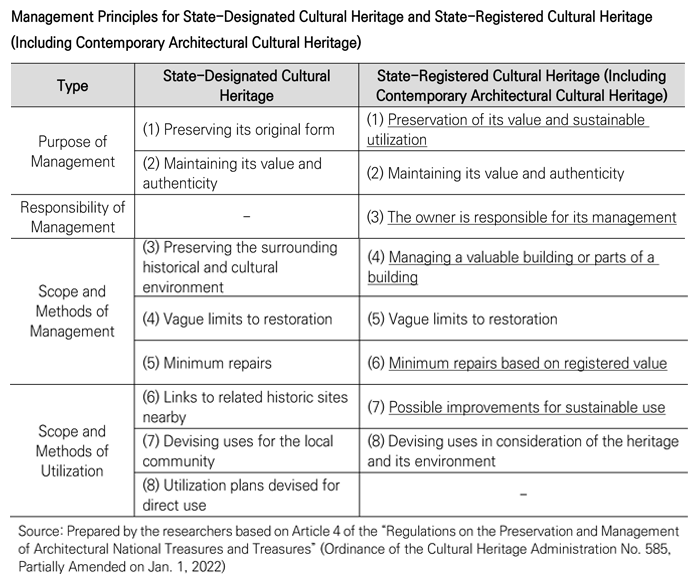
Improvement Measures for the State-registered Cultural Heritage Support System
- Managing Registered Value by Monitoring Regular Investigations
To achieve the two goals of state-registered cultural heritage, the preservation of value and sustainable utilization, it is necessary to open the possibility of usage while simultaneously conducting maintenance, management, and monitoring to preserve the value of cultural heritage. However, any alterations to state-registered cultural heritage should be reported in most cases, and doing so involves quite a lengthy procedure and much time for notification about the alteration of the current state of the cultural heritage to reach the Cultural Heritage Administration through the basic local government and the metropolitan local government. This demonstrates a limit to managing the preservation conditions of the historical value of state-registered cultural heritage only through notifying and authorizing alterations. Unlike state-designated cultural heritage, state-registered cultural heritage is assumed to be eligible for permissions on alterations if it is covered by an exemption law, received state subsidies, or is owned by the state or the public. However, the number of cases that are covered by any exemption law is exceedingly low, and a large percentage of state-registered cultural heritage sites do not obtain the relevant permission, given that 47.3% of state-registered cultural heritage sites did not receive subsidies through the repair and maintenance (lump-sum budget) program in the last decade.
Under such circumstances, the regular investigations of state-registered cultural heritage, which have been conducted since 2018, have confirmed the effectiveness of basic monitoring, as most of the registered cultural heritage sites that were determined to require repairs in the previous regular investigations have been fixed. The follow-up procedures of the current regular investigation mainly consist of repairs and reinforcing structural safety and do not serve the role of managing the registered value of the cultural heritage in detail. However, it will be more efficient for regular investigations, the effectiveness having been confirmed, to be accompanied by the monitoring of registered value, comprising the core preservation elements of state-registered cultural heritage. Considering that basic information about the preservation status by material and the original form of the cultural heritage is being collected through the “Regular Investigation Form for State-registered Cultural Heritage (Buildings)”,7) regular monitoring of the registered value of state-registered cultural heritage will be possible by simply editing the terms and structure of the form. This can be an effective tool for managing the “core preservation elements” presented in Article 8 of the “Modern and Contemporary Cultural Heritage Act,” that is, preserving buildings and their environments by focusing on their registered value instead of opting to freeze them in their original forms.
- Re-establishing the Criteria for the Repairs and Maintenance (Lump-Sum Budget) Program
The budget for the Repairs and Maintenance (Lump-Sum Budget) Program for state-registered cultural heritage has continued to increase yearly, contributing to preserving state-registered cultural heritage. However, records of support over the past decade have shown that 47.3% of state-registered cultural heritage sites have never received any support, while certain sites had a tendency to receive funding multiple times. Adding to this situation, recent changes in the regulations allowed for high-rise and large-scale buildings, which have been built since the 1960s and are ten floors or higher, to be considered state-registered cultural heritage. Because these buildings display various value elements and require various preservation and utilization methods other than preserving their original forms, such as restoring and improving their functions, even supporting the repairs and maintenance of a single building can incur billions of won in preservation and maintenance costs.
Therefore, it is necessary to revise the current support criteria for the state-registered cultural heritage repairs and maintenance program. First, as mentioned above in relation to the management principles for state-registered cultural heritage, the principle of maintenance and management by the owner should be established by expanding their responsibilities as virtuous managers, as stipulated in Article 12 of the “Modern and Contemporary Cultural Heritage Act.” In the case of other countries, such as Japan and the United Kingdom, the scope of repairs is limited, and while state support is provided, the owners are responsible for a specific portion of the required budget. By benchmarking such examples, state-registered cultural heritage should be managed by restricting the scope of government support and granting both the authority and responsibility of managing cultural heritage entities to the respective owners.
For cultural heritage requiring repairs and maintenance support, the focus should be shifted to the core preservation elements concerning registered values rather than the entire building and its surroundings. Given that reorganization of the surrounding environment falls under the owner’s responsibility for sustainable utilization rather than preserving the heritage’s registered value, support should primarily target public elements, such as public viewings. Exceptions for restoring and implementing safety measures for the entire cultural heritage, including the core preservation elements, will be necessary in cases of emergencies, such as post-disaster recovery efforts or support for safety measures.
Furthermore, the cultural heritage sites’ records of receiving state subsidies and their amounts over the last ten years should also be considered when selecting repair and maintenance support recipients. The scale, number of instances, and cycle of support cannot be limited for all cases, as each cultural heritage varies in scale, preservation state, and financial circumstances. However, the scope of support can be expanded by considering the previous support details and history, at the very least, through a review of support program records.
The selection and management of state-registered cultural heritage repairs and management program recipients are guided by the “Regulations on the Operation and Management of the National Subsidy Program for the Repairs and Maintenance of Cultural Heritage (Lump-Sum Budget)” and the “Guidelines on the Implementation of State-registered Cultural Heritage Repairs and Maintenance Program.” Therefore, Article 5 (Recipients and Details of the Program) of the Regulations and some sections of the Guidelines require amendments. These regulations should be amended in consideration of the basic management principles for state-registered cultural heritage, including preservation centered on the registered value and the core preservation elements, owners’ responsibilities as regards the maintenance and management of the cultural heritage, and performance enhancements for sustainable utilization.
- Improving the Technical Support System
State-registered cultural heritage sites are currently excluded from receiving technical support, such as technical guidance and design reviews and are not subject to relevant laws. This limits them from effectively managing their registered value, including the core preservation elements, when conducting repairs, fixes, or improving their performance. Additionally, buildings from the 1960s and 1970s, which are newly added candidates for state-registered cultural heritage following the “50 years or older” registration criterion, use materials and construction methods that differ from existing cultural heritage buildings, which calls for the development of new technical guidance measures to accommodate the new additions. Accordingly, major technical support systems, including technical guidance, design reviews, and guidelines on repairing or fixing state-registered cultural heritage, should be established and improved.
While the “Act on Repair of Cultural Heritage” stipulates the technical support for cultural heritage, such as repairs, on-site surveys and designs, and supervision, state-registered cultural heritage is not included in this act.8) As a result, state-registered cultural heritage is excluded from the overall policy framework related to cultural heritage repairs as provided in the “Act on Repair of Cultural Heritage,” including the establishment of a master plan, the Cultural Heritage Repair Technology Committee, cultural heritage repair engineers, cultural heritage repair technicians, cultural heritage repair businesses, contracts and subcontracts, supervision, and inspections.9) Furthermore, the “Guidelines on the National Subsidy Program for the Repairs and Maintenance of Cultural Heritage” provides regulations for repair and maintenance projects, but it outlines that repairs should be managed and designs can be changed in accordance with the Act on Repair of Cultural Heritage, meaning that it is unclear with regard to state-registered cultural heritage sites, which are not covered by the law, on managing repairs and making changes to the designs. Given that state-registered cultural heritage can be repaired for better performance with the aims of preservation and sustainable utilization, the system should be enhanced to enable design reviews for design changes and provide technical support for repairs.
State-registered cultural heritage sites possess technological traits that set them apart from state-designated cultural heritage sites, as they include buildings that were built after the opening of ports and up until the 1970s, using a variety of technologies, materials, and construction methods. In particular, continuous R&D research on preservation technologies for various materials and construction methods is needed to provide technical support for new modern architectural heritage, such as the high-rise concrete buildings from the 1960s and 1970s that have recently been included in the scope of state-registered cultural heritage. The case of the United Kingdom, which has developed and manages a set of preservation and utilization guidelines for each material and building type, will be helpful in this case. Ultimately, it is essential to include state-registered cultural heritage in the scope of the “Act on Repair of Cultural Heritage” to incorporate and manage it within the institutional framework for cultural heritage repair.
1) Clause 1, Article 34 of the “Enforcement Decree of the Cultural Heritage Protection Act” (Enforced on May 22, 2023. Ordinance of the Ministry of Culture, Sports and Tourism No. 494, Partially Amended on Nov. 21, 2022)
2) Article 6 of the “Act on the Preservation and Utilization of Modern and Contemporary Cultural Heritage” (Enforced on Sep. 15, 2024, Act No. 19702, Enacted on Sep. 14, 2023)
3) The 2021 regular investigation included a re-investigation of 157 cases from 2018.
4) Written by the researchers in reference to the Cultural Heritage Administration (2016; 2021). “Cultural Heritage Seen Through Statistics”; Cultural Heritage Administration (2022). "2022 Financial Status of Cultural Heritage Management"
5) Article 56 of the “Cultural Heritage Protection Act” (Enforced on Aug. 8, 2023, Act No. 19592, Amendment by the Other Act on Aug. 8, 2023)
6) Articles 3 and 8 of the “Act on the Preservation and Utilization of Modern and Contemporary Cultural Heritage” (Enforced on Sep. 15, 2024, Act No. 19702, Enacted on Sep. 14, 2023)
7) “Guidelines on Regular Investigations on State-registered Cultural Heritage and State-designated Cultural Heritage” Appendix 7.
8) The items subject to repair of cultural heritage were limited to designated cultural heritage and provisionally designated cultural heritage in Article 2 (Definitions) of the “Act on Repair of Cultural Heritage.”
9) Despite originating from the same period as some of the state-registered cultural heritage buildings, buildings designated as modern historical sites (state-designated cultural heritage) are subject to the “Act on Repair of Cultural Heritage” because they are classified as designated cultural heritage, a higher class than state-registered cultural heritage.
- Korea National Heritage Online, UNESCO Hall. www.heritage.go.kr
- Guidelines on Regular Investigations on State-registered Cultural Heritage and State-designated Cultural Heritage (Enforced on Jan. 1, 2020, Ordinance of the Cultural Heritage Administration No. 516, Partially Amended on Dec. 17, 2019).
- Regulations on the Preservation and Management of Architectural National Treasures and Treasures (Ordinance of the Cultural Heritage Administration No. 585, Partially Amended on Jan. 1, 2022).
- Act on the Preservation and Use of Modern and Contemporary Cultural Heritage (Enforced on Sep. 15, 2024, Act No. 19702, Enacted on Sep. 14, 2023).
- Regulations on the Operation and Management of the National Subsidy Program for the Repairs and Maintenance of Cultural Heritage (Lump-Sum Budget) (Enforced on Jan. 22, 2020, Ordinance of the Cultural Heritage Administration No. 530, Enacted on Jan. 22, 2020).
- Cultural Heritage Protection Act (Enforced on Aug. 8, 2023, Act No. 19592, Amendment by Other Act on Aug. 8, 2023).
- Enforcement Decree of the Cultural Heritage Protection Act (Enforced on May 22, 2023. Ordinance of the Ministry of Culture, Sports and Tourism No. 494, Partially Amended on Nov. 21, 2022).
- Act on Repair of Cultural Heritage (Enforced on Aug. 8, 2023, Act No. 19592, Amendment by Other Act on Aug. 8, 2023).
- Cultural Heritage Administration. (2010). Standard Specifications for the Repair of Modern Cultural Heritage Buildings.
- Cultural Heritage Administration. (2016). Cultural Heritage Seen Through Statistics.
- Cultural Heritage Administration. (2021). Cultural Heritage Seen Through Statistics.
- Cultural Heritage Administration. (2022a). 2022 Financial Status of Cultural Heritage Management.
- 2022 Financial Status of Cultural Heritage Management.
- Cultural Heritage Administration. (2022b). Regular Investigation on State-registered Cultural Heritage (Buildings) (2018-2021). Internal Report.
- Cultural Heritage Administration. (2022c). Budget Support for Repairs and Maintenance of State-registered Cultural Heritage (2013-2022). Internal Report.
- Cultural Heritage Administration Website. Basic Data on Cultural Heritage Status (As of Dec. 31, 2022). https://www.cha.go.kr/html/HtmlPage.do?pg=/cultural_info/cultureTotal_ccrebasi_kor.jsp&mn=NS_03_07_03 (Viewed Sep. 18, 2023)
- Lee, G., Son, E., Park, I., and Kim, S. (2022). Commissioned Report for Establishing Registration Criteria and Preservation and Management Methods for Modern Architectural Cultural Heritage. Cultural Heritage Administration.
- Suzuki, H. (2001). Contemporary Architectural Preservation Theory. Okokusha.
